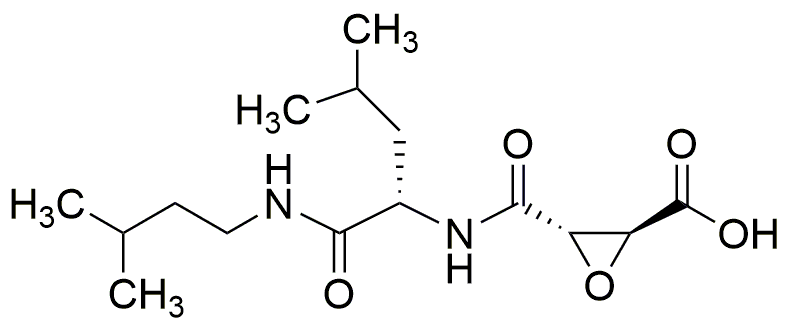L-Trans-Epoxysuccinyl-Leu-3-methylbutylamide is widely utilized in research focused on:
- Pharmaceutical Development: This compound is often used in the synthesis of peptide-based drugs, providing a scaffold for developing new therapeutic agents targeting various diseases.
- Biochemical Research: It serves as a valuable tool in studying enzyme mechanisms and protein interactions, helping researchers understand biological processes at a molecular level.
- Drug Delivery Systems: The compound can be incorporated into drug delivery formulations, enhancing the stability and bioavailability of active pharmaceutical ingredients.
- Neuroscience Studies: It is utilized in research related to neuroprotective agents, potentially leading to advancements in treatments for neurodegenerative diseases.
- Analytical Chemistry: This chemical is employed in various analytical techniques, aiding in the detection and quantification of biomolecules in complex samples.
Informations générales
Propriétés
Sécurité et réglementation
Applications
L-Trans-Epoxysuccinyl-Leu-3-methylbutylamide is widely utilized in research focused on:
- Pharmaceutical Development: This compound is often used in the synthesis of peptide-based drugs, providing a scaffold for developing new therapeutic agents targeting various diseases.
- Biochemical Research: It serves as a valuable tool in studying enzyme mechanisms and protein interactions, helping researchers understand biological processes at a molecular level.
- Drug Delivery Systems: The compound can be incorporated into drug delivery formulations, enhancing the stability and bioavailability of active pharmaceutical ingredients.
- Neuroscience Studies: It is utilized in research related to neuroprotective agents, potentially leading to advancements in treatments for neurodegenerative diseases.
- Analytical Chemistry: This chemical is employed in various analytical techniques, aiding in the detection and quantification of biomolecules in complex samples.
Documents
Fiches de données de sécurité (FDS)
La FDS fournit des informations de sécurité complètes sur la manipulation, le stockage et l’élimination du produit.
Spécifications du produit (PS)
Le PS fournit une description complète des propriétés du produit, notamment sa composition chimique, son état physique, sa pureté et les exigences de stockage. Il détaille également les plages de qualité acceptables et les applications prévues du produit.
Certificats d'analyse (COA)
Recherchez des certificats d'analyse (COA) en saisissant le numéro de lot du produit. Les numéros de lot et de lot se trouvent sur l'étiquette d'un produit, après les mots « Lot » ou « Lot de fabrication ».
Numéro de catalogue
Numéro de lot/série
Certificats d'origine (COO)
Ce certificat d'exploitation confirme le pays dans lequel le produit a été fabriqué, et détaille également les matériaux et composants utilisés et s'il est issu de sources naturelles, synthétiques ou autres sources spécifiques. Ce certificat peut être requis pour les douanes, le commerce et la conformité réglementaire.
Numéro de catalogue
Numéro de lot/série
Fiches de données de sécurité (FDS)
La FDS fournit des informations de sécurité complètes sur la manipulation, le stockage et l’élimination du produit.
DownloadSpécifications du produit (PS)
Le PS fournit une description complète des propriétés du produit, notamment sa composition chimique, son état physique, sa pureté et les exigences de stockage. Il détaille également les plages de qualité acceptables et les applications prévues du produit.
DownloadCertificats d'analyse (COA)
Recherchez des certificats d'analyse (COA) en saisissant le numéro de lot du produit. Les numéros de lot et de lot se trouvent sur l'étiquette d'un produit, après les mots « Lot » ou « Lot de fabrication ».
Numéro de catalogue
Numéro de lot/série
Certificats d'origine (COO)
Ce certificat d'exploitation confirme le pays dans lequel le produit a été fabriqué, et détaille également les matériaux et composants utilisés et s'il est issu de sources naturelles, synthétiques ou autres sources spécifiques. Ce certificat peut être requis pour les douanes, le commerce et la conformité réglementaire.

